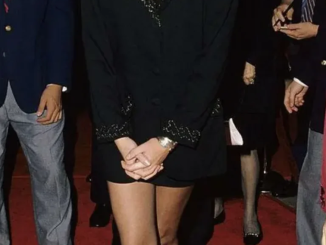Brenda Lee’s name may not be as recognizable as some of the other music stars from the 1960s but when you think of Christmas, you’ll know her song, and start humming her catchy tune, “Rockin’ Around the Christmas Tree.”
When Lee, now 78, first hit the stage, she wasn’t old enough to drive but her powerful vocals steered her “unprecedented international popularity” as the most successful female artist of the 1960s.
Lee, whose voice defied her diminutive stature at only 4 foot 9, became a fan favorite when she was only 12.
Brenda May Tarpley, born in 1944, got her start in the late 1940s, became huge in the 1950s, and over her career–that started before she left elementary school–she topped the charts 55 times, earning the title as the most successful female recording artist of the 1960s.
When Lee was only eight (according to Rolling Stone), her father, a construction worker, was killed at work and little Brenda–who then changed her last name to Lee–became the family’s primary provider.

Taking care of her younger brother, big sister, and mother–a cotton mill worker–was not a duty, but something she wanted to do. She said that she was thrilled when she made her first $20, so she could help her family: “Even at that young age, I saw that helped our life,” Lee said, adding “It put some food on the table. It helped, and I loved it.”
The Atlanta-born chanteuse, called a “pioneer of early rock and roll,” by the Georgia Encyclopedia, achieved “unprecedented international popularity in the 1960s.”
But, an incredibly humble human, Lee credits those who helped her achieve her dreams. When Christianity Today asked what she thinks about being a legend, Lee said “I don’t think of myself that way!” She continued, “I’m just a girl who’s been blessed to be doing what I’m doing, and there’s a lot of people who’ve sweated a lot of tears and put a lot of life’s work into me to be able to have my dream. So, if I’m a legend, then they’re legends, too.”
In 1956, the young girl joined country star Red Foley for a show at the Bell Auditorium near her home in Augusta, and she belted out “Jambalaya,” by Hank Williams.

She was then signed to appear on Foley’s Ozark Jubilee, a country music show, where millions of viewers fell in love with the sassy 12-year-old whose talent was developed well beyond her age.
In the same year, Lee signed with Decca Records, and the next year, she moved to Nashville, Tennessee, and fusing country with rhythm and blues–highlighted by her hiccupping vocals–she recorded early rockabilly classics like “BIGELOW 6-200,” “Little Jonah,” and “Let’s Jump the Broomstick.”
When asked if–when as a young girl–she was nervous performing in front of large crowds, she answered: “No, not really. Nobody ever told me to be nervous. The stage always felt like a hometown to me because I had been in front of people ever since I was 3 years old, singing to people. So it was a very comfortable spot for me.”
In 1957, Lee earned the nickname “Little Miss Dynamite” for her pint-sized powerhouse recording of the song “Dynamite,” and in 1958, fans heard “Rockin’ around the Christmas Tree,” a genre and generation-crossing holiday standard, released when she was only 13.
“I knew it was magical,” she told Rolling Stone.
Over the next couple of years, she charted with hits like “Sweet Nuthin’s,” “All Alone Am I,” and “Fool #1.”
Most of her songs, however, contradicted her experience as a young girl. Her mother didn’t let her date and she graduated high school not understanding the heartbreak of young love.

She was only 16 when she said “Love could be so cruel” in the song “I’m Sorry” and only 16 when she said “I want his lips to kiss me” in the song “I Want to be Wanted,” both back-to-back hits when she was still in school.
And when she turned 18, she met Ronnie Shacklett, whom she’s now been happily married to for 60 years.
Life on the road for Lee as a youngster had its difficulties. She celebrated her 12th birthday in Las Vegas and speaking with the Las Vegas Journal, Lee explained her loneliness.
“Of course, I wasn’t even allowed to walk through a casino, I was so young. So I didn’t even know what a casino looked like. They took me into the kitchen, then into the showroom. And then when my show was over, I was brought back out through the kitchen and back up to my room. Children weren’t allowed … in the casino area.” She continued, “There wasn’t anything to do in Vegas for a kid. The most fun I had was on the stage.”
Speaking on what she missed out on as a child, the award-winning Lee said, “Many times, I yearned to be with my friends rather than be out there on the road.”
Turns out she made new friends on the road, like with the music group that opened for her at a 1962 show in Germany. “I hung out with John,” she says effortlessly, speaking of John Lennon. “He was extremely intelligent, very acerbic with his jokes, just a gentle person. When I found out that they later said they were fans of my music, I was just floored.”

I Have to Raise Someone Else’s Child While Her Mom Is Having Fun at Parties – Story of the Day

I fell in love with a pregnant woman and promised to help her raise the baby, but she decided to have fun and avoid her responsibilities. She abandoned me only to return years later to do something unspeakable.
I met Molly at college. She was the most beautiful girl I had ever seen, but she never gave me the time of day. Molly would often hang out with the most popular men, usually on the school’s football team, but we became close friends.
She was cheerful and a great student. It was just amazing to have a friend like that, even if my feelings would always be unrequited. Eventually, she started dating Tanner, the captain of the team. He wasn’t a typical mean jock, but I always thought she could do better.

Molly didn’t know she was pregnant. | Source: Shutterstock
A few months afterward, Molly came to my house crying. Tanner had dumped her and started dating another girl almost immediately. I comforted her as best I could, but she had really loved him. About a month after that, she discovered something life-changing.
“Mark, I’m pregnant,” she told me.
“What?” I exhaled. I couldn’t believe it. “Did you tell Tanner already?”
“Yes. He doesn’t want anything to do with the baby. He told me to get rid of it because he’s not going to be a father now,” Molly replied.

Molly discovered she was pregnant. | Source: Pexels
“What an idiot! I can’t believe he would evade his responsibilities like that! What are you going to do?” I questioned.
“I don’t know. I don’t want to get rid of it, but I’m in college. I can’t be a single mom. My parents are going to kill me,” she cried.
“I’ll step up. We can get married, and I’ll help you raise the baby. You won’t be alone,” I suggested without thinking about it twice.
“I can’t ask you to do that. I’m sorry, Mark. But I don’t think I’ll ever feel that way about you,” Molly said apologetically.

I stepped up. | Source: Pexels
“Don’t worry. It’s not about that. We’ll get married so that no one will look down on you, and you won’t be a single mother,” I continued. It sounded crazy even to me, but I couldn’t let Molly go through this alone.
“Are you sure? That’s a lot to ask of a friend,” Molly whispered, still hesitant about this insane idea. I assured her I was serious, and we went down to the courthouse later that week. Two of our friends served as witnesses, and it was a short affair.
I helped Molly get through this pregnancy as best I could. It was difficult as we were both college students, but we would make it work together. I grew more excited every day, thinking of becoming a father.

I adored Amelia. | Source: Pexels
But Molly was not that enthusiastic. I could tell that she missed being able to go out with her friends and enjoying regular college life. But as a mother, she had to sacrifice a lot. Eventually, Amelia was born, and she was the most beautiful baby in the world.
I adored her immediately and became her dad. Molly loved Amelia as well and settled into being a mother better than I expected. We became a wonderful little family, and no one suspected that Amelia was not mine because she looked exactly like her mother.
But Molly grew less and less excited. When Amelia was five years old, Molly broke down after putting her to bed. “I can’t do this anymore. I lost everything!” she cried.

Molly packed her bags and left. | Source: Pexels
“What are you talking about?” I asked her.
“I lost my entire youth. I shouldn’t have had a kid at all!” Molly continued.
“Molly, please. Amelia might hear you. She’s in the next room!” I said, raising my voice only a bit.
“I don’t care. I want out of this. I’m filing for divorce, and I don’t want to see any of you again,” she said, shocking me to my core. I asked her to stop and think about this, but Molly had already packed her bags and left us forever.

Amelia missed her mother. | Source: Pexels
I went to Amelia’s room only to discover that our daughter had heard the entire commotion. “Mommy left?” she cried.
“Baby, your mother is going through something right now and needs some time away. She’ll be back soon,” I assured her.
Unfortunately, Molly did not return, and I became a single father. It was harder than I ever expected, and Amelia would cry almost every single night for a year afterward. But soon enough, we both got used to being on our own. My daughter was the light of my life, and I would do anything to get us through.

I did my best raising Amelia as a single father. | Source: Pexels
Molly did not call once but would update her social media often. She had the college life she had missed all this time. It was one party after another with her old college sorority friends. I felt awful seeing those pictures.
How could she abandon her child to go out and have fun? It was unforgivable. Several years after her abandonment, I saw that she and Tanner had gotten back together, which only hurt worse. This was the guy who dumped her at her most vulnerable and didn’t want to step up for his baby.
I couldn’t do anything about it except move on, but Molly decided to come back into our lives just when we were doing so well. “What do you mean you want Amelia back?” I asked when Molly showed up at my house unexpectedly.

Molly returned and threatened to take me to court. | Source: Pexels
“Molly is my daughter, and I want her to live with me. Tanner is finally ready to meet her. She’s her father,” she said nonchalantly.
“Tanner is not her father. I’m her father. I raised her all these years, especially when you abandoned her,” I said with disdain in my voice.
“Mark, don’t do this. I will take you to court for custody if I have to. That’s my child. Tanner and I are engaged. She is going to be so happy with her real family at last,” Molly continued.

We went to trial. | Source: Pexels
“I’ll see you in court then,” I replied and threw Molly out of my house. Amelia was almost a teenager by then and saw how worried I was. My lawyers advised me to settle things out of court because most judges side with the mother.
But how could a judge side with Molly after her abandonment? My name was on Amelia’s birth certificate, and I saw her grow up. I was her only father. Molly’s lawyers were fierce, and our battle was harsh. But Amelia’s testimony sealed the deal.
“I only have one father,” she said, pointing at me. “My mother left many years ago after saying she regretted me. I don’t want to live with her.”

Nothing would ever separate my daughter and I. | Source: Pexels
Luckily, the judge listened to my little girl, although my lawyers didn’t think it would happen. He gave me full custody, while Molly got visitation on the weekends. I encouraged Amelia to forgive her mother and build a relationship with her, which they did.
But she told me every day that I was the best father anyone could ever have.
What can we learn from this story?
- Appreciate what you have. Molly threw her family away and discovered later in life that she couldn’t exactly get it back.
- Some responsibilities require sacrifices. Getting pregnant at a young age is a big deal, which means that you might have to give up partying and other youthful shenanigans.
Share this story with your friends. It might brighten their day and inspire them.
If you enjoyed this story, you might like this one about a woman who abandoned her daughter to travel the world and have a fun time.



Leave a Reply